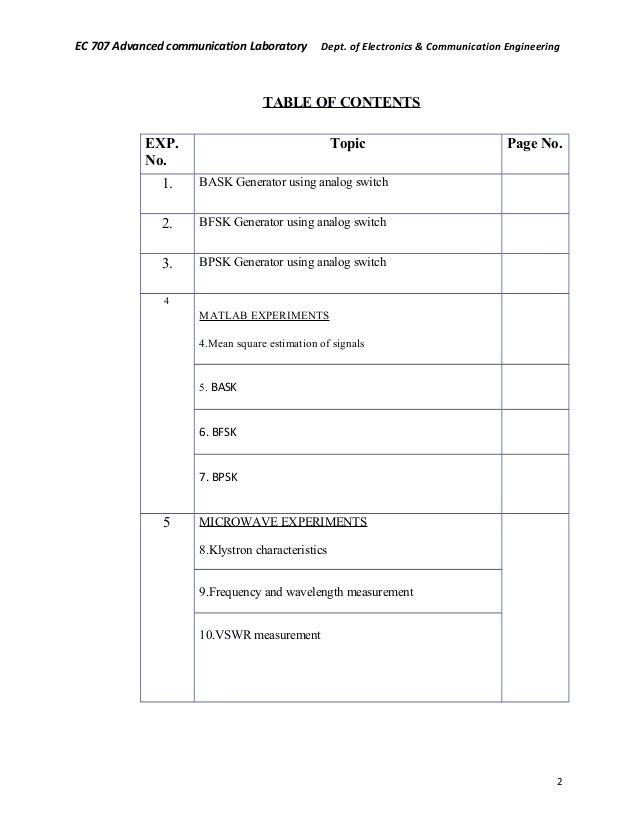Oct 19, 2018 - 6th sem e c vtu digital communication lab manual. Fri, 19 Oct 2018. Lab Manual Advanced. Manual Vtu Ec 6th Sem.
1930 Ford Model A and AA Owners Manual 30 Car and Truck Instruction Guide Book. 1930 Ford Owner Instruction & Operating Manual Covers Model A Cars & Model AA Trucks & Pickups 30. 'Ford Model 'A' Instruction Book' This is a quality reproduction of the manual that was issued with all. Find great deals on eBay for Ford Model A Manual in Other Models. New 1930 Ford Model A Car Instruction Manual Owners Guide Operator Book. Ford Model A & AA owner's manuals for 1928-1931 Ford Model A & AAs. Buy 1928 1929 1930 1931 FORD MODEL A Service Manual Book: Software - Amazon.com ✓ FREE DELIVERY possible on eligible purchases. 1930 ford model a service manual.
- Advanced Communication Lab Manual Vtu 6th Sem Syllabus
- Advanced Communication Lab Manual Vtu 6th Sem Results
- Advanced Communication Lab Manual For 6th Sem Vtu
Contents TDM Time Division Multiplexing Modulation The Circuit Diagram is as shown below Demodulation The First Part of the demodulation circuit consists of two transistors, one NPN and the other PNP, to separate the two multiplexed waves. This is followed by Low Pass Filters tuned to the transmitting frequency (f1 or f2) The Circuit Diagram is as shown below For simplicity we can assume: R1=R2, C1=C2 and R3=R4, C3=C4. We can then use the equation f=1/(2.pi.R.C) where f=f1, R=R1, C=C1 in the first case and f=f2, R=R3 and C=C3 in the second case.
For f1=1kHz and f2=600Hz we get R1=, C1=, R3=, C3=, ASK Amplitude Shift Keying generation and detection (binary) Amplitude-shift keying (ASK) is a form of modulation that represents digital data as variations in the amplitude of a carrier wave. An ASK signal (below) and the message (above) The amplitude of an analog carrier signal varies in accordance with the message/modulating signal (bit stream), keeping frequency and phase constant. The level of amplitude can be used to represent binary logic 0s and 1s. We can think of a carrier signal as an ON or OFF switch. In the modulated signal, logic 0 is represented by the absence of a carrier, thus giving OFF/ON keying operation and hence the name given. Modulation The message signal is a NRZ Unipolar (ON/OFF) format message signal, and the sinusoidal carrier signal are multiplied with each other.
Advanced Communication Lab Manual Vtu 6th Sem Syllabus
The resultant is an ASK signal. Whenever the message signal is '0' (represented by 0 volts) the output at the collector of the transistor is 0. When the message signal is '1' (represented by say 5 volts) the output at the collector of the transistor is a sinusoidal signal of amplitude=(amplitude of carrier).(amplitude of message) The Block Diagram is as shown: The carrier signal is a sine wave of 10kHz, and the message signal is a square wave of 1kHz. The circuit is constructed as shown and the output is measured using a CRO.
Advanced Communication Lab Manual Vtu 6th Sem Results
The amplitude of message signal is nominally set at 3V (peak to peak) and the carrier signal is set at 5V (peak to peak) Demodulation The first part of the demodulation circuit is a half wave rectifier, followed by a low pass filter and a comparator. The diode will remove any unwanted negative amplitudes introduced due to noise. The low pass filter will remove the high frequency carrier.Then a comparator circuit is used, with the threshold voltage=(amplitude of message signal)/2 to estimate the transmitted pulses. If the input pulse is greater than the threshold voltage, a new '1' is generated, if the input is lesser than the threshold voltage then a new '0' is generated at the output. The Circuit Diagram is as shown: Vref is the threshold voltage and hence must be half of the maximum amplitude of the message signal. In our example we have set the message signal amplitude at 3V hence Vref=1.5V FSK Frequency Shift Keying generation and detection (binary) Frequency-shift keying (FSK) is a form of frequency modulation in which the modulating signal shifts the output frequency between predetermined values.
Advanced Communication Lab Manual For 6th Sem Vtu

An FSK waveform, derived from a binary message A carrier of frequency f1 BPSK Binary Pulse Shift Keying Modulation The block diagram is as shown below The message signal is a square wave of 1kHz and carrier signal is a sine wave of 10kHz. Demodulatio The block diagram is as shown below Vref must be lesser than half the amplitude of the message signal. Gunn Diode Reflex Klystron.